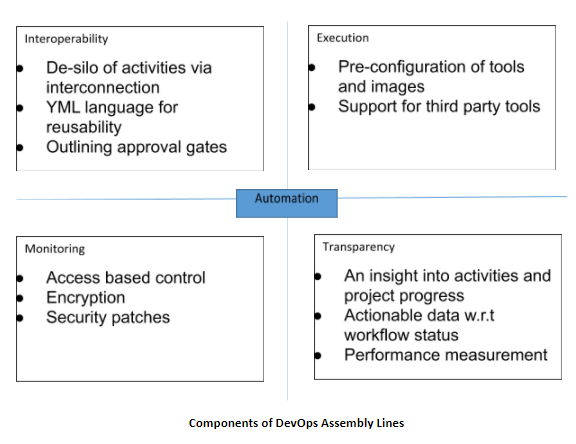Making DevOps Sensible with Assembly Lines

Audio : Listen to This Blog.
DevOps heralded an era of cutting edge practices in software development and delivery via Continuous Integration (CI) Pipelines. CI made DevOps an epitome of software development and automation, entailing the finest agile methodologies. But, the need for quicker development, testing, and deployment is a never-ending process. This need is pushing back the CI and creating a space for a sharper automation practice, which runs beyond the usual bits and pieces automation. This concept is known as DevOps Assembly Lines.
Borrowing inspiration from Automobile Industry
The concept of assembly lines was first started at Ford Plant in the early 20th century – the idea improved continuously and today is powered via automation. Initially, the parts of the automobiles were manufactured and assembled manually. This was followed by automation in manufacturing, while the assembly was manual. So, there were gaps to be addressed for efficiency, workflow optimization, and speed. The gaps were addressed by automating the assembly of parts. Something similar is happening in the SDLC via DevOps Assembly Lines.
Organizations that implement advanced practices of DevOps follow a standardized and methodological process throughout the teams. As a result, these organization experiences fast-flowing CI pipelines, rapid delivery, and top quality.
A silo approach that blurs transparency
Following the DevOps scheme empowers employees to deliver their tasks efficiently and contribute to the desired output of their team. Many such teams within a software development process are leveraging automation principles. The only concern is that this teamwork is in silos hindering overall visibility into other teams’ productivity, performance, and quality. Therefore, the end product falls shorts of desired expectations – often leaving teams perplexed and demotivated. This difference in DevOps maturity within different teams in a software development environment calls for a uniform Assembly Line.
Assembly Lines – triggering de-silo of fragmented teams
CI pipelines consist of a host of automated activities that are relevant to individual stages in the software lifecycle. Which means there are a number of CI pipelines operating simultaneously; but, it is fragmented within SDLC. Assembly Lines is an automated conflation of such CI pipelines towards accelerating a software product’s development and deployment time. DevOps Assembly Line automates activities like continuous integration in the production environment, configuration management and server patching for infrastructure managers, reusable automation scripts in the testing environment, and code as monitoring scripts for security purposes.
Bridging the gap between workflows, tools and platforms
DevOps Assembly Lines creates a perfect bridge, finely binding standalone workflows, and automated tools and platforms. This way, it establishes a smoothly integrated chain of deployment pipeline optimized for the efficient delivery of software products. The good part is it creates an island of connected and automated tools and platforms; these platforms belong to different vendors and are that gel together easily. Assembly Lines eliminates the gap between manual and automated tasks. It brings QAs, developers, operations teams, SecOps, release management teams, etc. on a single plane to enable a streamlined and uni-directional strategy for product delivery.

Managed platform as a service approach for management
DevOps Assembly Lines exhibits an interconnected web of multiple CI pipelines, which entail numerous automated workflows. This makes the management of Assembly Lines a bit tricky. Therefore, Organizations can leverage a managed services portal that streamlines all the activities across the DevOps Assembly Lines.
Installing a DevOps platform will centralize the activities of Assembly Lines and streamline a host of workflows. It will offer a unified experience to multiple DevOps teams and also help operate a low cost and fast-paced Assembly Lines. A DevOps platform would also entail different tools from multiple vendors that could work in tandem.
The whole idea behind installing Assembly Lines is to establish a collaborative auto-mode within diverse activities of SDLC. A centralized, on-demand platform could help get started with pre-integrated tools, that could manage automated deployment.
A team of operators, either in-house or via a support partner, could handle this platform. This way, there will be smooth functioning across groups, and on-demand requests for any issues that could be addressed immediately. The platform will invariably help DevOps architects to concentrate on productive parts – while maintenance is taken care of behind the scenes. Further, it would allow teams to look beyond their core activities (a key goal of Assembly Lines) and absorb the status of overall team productivity. The transparency will give them an idea of existing hindrances, performances, productivity, and expected quality. In accordance, they could take corrective measures.
Future Ahead
CI pipelines are helpful for rapid product development and deployment. But, considering the graph of rising expectation in quality and feature enablement and considering the time-to-market requirement, the CI pipelines do not fit the bill. Further, the issue of configuration management is too complicated for CI pipelines to handle. Therefore, the next logical step is to embrace DevOps Assembly Lines. And the importance of a centralized management platform to drive consistency, scalability, and transparency via Assembly Lines should not be undermined.
